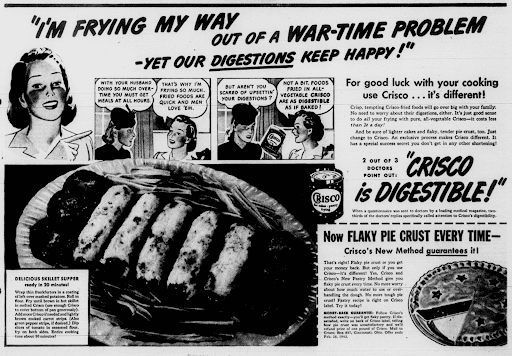
Our main guide for this survey of the harmfulness of seed oils is the fact-filled article, “What Are Seed Oils And Should You Avoid Them?” (Emily Ziedman, MS, Zero Acre, 5-8-22). She massively backs up her contentions with references from conventional, reputable scientific / medical journals. In other words, this is not just unsupported rantings from someone who has an “alternative / holistic” view, which many — often with a marked irrationality and/or unfounded bias, in my experience — regard as controversial or even conspiratorial.
The proof’s in the pudding, and that comes down to research from the standard peer-reviewed journals (e.g., British Medical Journal, JAMA, Lancet, New England Journal of Medicine, Nature, et al). I became familiar with these famous journals while working at the medical library at Wayne State University in Detroit, from 1977 to 1979. I will not only be referencing what Emily Ziedman cites, but many other related scientific articles as well. Thus, whoever disagrees with my conclusions, will ultimately have to grapple with those sources, not me. I’m simply citing the experts. Disagree if you must, but back it up (as I will be doing). That’s how scientific inquiry works.
I myself have been an advocate of a holistic philosophy of health, natural and whole foods, alternative medicine, vitamins and mineral supplements, herbalism, etc. since 1983, when I researched and effectively controlled my hypoglycemia (low blood sugar). Through the years, my wife Judy and I have been able to successfully treat numerous conditions or maladies by these means, effectively and at low cost, and I have written a lot about it, in the effort to help others as well.
We seem to have “reaped what we have sowed” now at age 66, with our worst health problems being my ulcer and her cataracts (recently removed) — nothing major life-altering, let alone life-threatening. It helps that we have followed — finances permitting! — a health-food, low-sugar, semi-vegetarian diet for forty years, and have not smoked or consumed much alcohol at all, or done any illegal drugs; and we keep physically active (hiking, biking, gym exercise, trimming and cutting trees and bushes, working on the house, sports to some extent).
Though I have been of this mind, I had never heard about the danger of seed oils until the last few months. It’s a new topic for me. I knew that I have often had trouble with fat, in general, but I thought that was just my fidgety stomach, and never thought about it beyond that. As far as I knew, seed oils were perfectly healthy (especially, canola, safflower, and sunflower oil) because they were low in saturated fat (as opposed to fat from meat and dairy products). But now I have become aware of a very concerning and serious overall health and diet situation, and once again I seek to learn and share what I learn. Ziedman writes in her Introduction:
If you look at most ingredient lists on your favorite packaged foods, you’ll likely see at least one type of vegetable oil. From chips to popcorn to granola bars, vegetable oils are everywhere, and overall consumption has increased dramatically over the last 100 years.
In fact, global production of vegetable oils has increased over 1600% since the early 1900s, has doubled in the last 20 years, and is expected to grow 30% in the next four years [1]. In the U.S., the consumption of soybean oil alone has grown 1,000-fold since 1909 [2].
And with this increase in vegetable oil consumption, chronic diseases like obesity, heart disease, cancer, and diabetes are also on the rise.
Today, at least 60% of American adults suffer from chronic illness — a 700% increase since the first survey on the topic in 1935 [3]. Before modern diets and lifestyles, chronic diseases were rare.
Ziedman continues:
Seed oils, often called industrial seed oils, are a type or subset of vegetable oils that are derived from seeds and are typically higher in linoleic acid, and therefore, may be worse for your health.
These oils are almost always derived from the seeds of crops and include:
- Corn
- Canola
- Cottonseed
- Soy
- Sunflower
- Safflower
- Grapeseed . . .
- Peanut
. . . seed oils were only introduced to the food supply in significant quantities about 100 years ago. First, in the form of shortening (Crisco), and soon after as the myriad of cooking oils we know today, . . . these new oils won their way into the hearts and homes of people across the United States [4].
What catapulted the popularity of seed oils, however, was a new surge of research published in the 1950s that unveiled the connection between saturated fat and heart disease. Traditional forms of dietary fat like butter and lard are rich in saturated fat, while seed oils are primarily made up of polyunsaturated fats. In an attempt to protect their hearts, Westerners moved away from butter and lard [5] [see also, tallow] and filled their cupboards with seed oils.
But, in the decades that followed, the research that initially bridged the connection between saturated fat and heart disease was put into question. We now know that seed oils, while low in saturated fat, are higher in certain types of unstable polyunsaturated fats and may have a much stronger correlation to heart disease and other chronic illnesses, from diabetes and autoimmune diseases to cancer.
Ziedman at this point cites a copiously researched (66 footnote references) article from BMJ Journals: openheart. Here is the summary:
The consumption of the omega-6 polyunsaturated fat linoleic acid has dramatically increased in the western world primarily in the form of vegetable oils. OxLDL is thought to play an important role in atherosclerosis formation; however, it is the oxidised linoleic acid contained in LDL that leads to harmful OXLAMs, which induces atherosclerosis and CHD. Thus, reducing the amount of dietary linoleic acid, mainly from industrial vegetable/seed oils, will reduce the amount of linoleic acid in LDL and likely reduce oxLDL as well as the risk for CHDcoronary heart disease.
In summary, numerous lines of evidence show that the omega-6 polyunsaturated fat linoleic acid promotes oxidative stress, oxidised LDL, chronic low-grade inflammation and atherosclerosis, and is likely a major dietary culprit for causing CHD, especially when consumed in the form of industrial seed oils commonly referred to as ‘vegetable oils’. [6]
According to the Centers for Disease Control and Prevention (CDC) [7], heart disease is the leading cause of death in the United States. In 2022, 702,880 people died as a result of it: one in every five deaths (and 20% of these deaths were among people younger than 65). The ensuing costs were about $252.2 billion from 2019 to 2020. CBS News (“Health Watch”) reported: “In a report released Tuesday, the American Heart Association says more than 6 in 10 U.S. adults (61%) will have some type of cardiovascular disease, or CVD, by 2050.” [8] NBC News further noted: “Nearly 90% of adults over age 20 in the United States are at risk of developing heart disease, an alarming new study [in JAMA] suggests.” [9] Certainly there are multiple causes for heart disease. But what we know about seed oils isn’t helping the situation at all.
Ziedman continues:
Seed oils are particularly rich in the omega-6 fatty acid known as linoleic acid, a fat that humans didn’t eat in high quantities until the last 100 years or so.
Your body requires both saturated fats and unsaturated fats to function. However, newer sources of fats like seed oils can skew the natural balance of fats in the body and may contribute to unprecedented levels of health issues, from skyrocketing obesity levels to heart disease and more.
Then she gets into how these oils are processed, noting that “synthetic antioxidants are added in an attempt to preserve the shelf life of the unstable fats in seed oils. These synthetic antioxidants, like TBHQ, BHA, or BHT are known carcinogens.” She notes,
The seeds are heated to extremely high temperatures, causing oxidative damage and transforming some PUFAs [polyunsaturated fatty acids] into damaging trans fats. The seeds are then extracted with a chemical solvent, such as hexane, which allows for a more optimal yield. Next, the seed oils go through the process of high-heat deodorization, which may further damage the unstable PUFAs and increase the production of trans fat once again.
And later in her article, “hexane is also used as a solvent in glues, varnishes, and inks and is used as an effective cleaning agent in the printing industry.” TBHQ, BHA, or BHT have been severe restricted as additives in Europe.
“Please Hit ‘Subscribe’”! If you have received benefit from this or any of my other 5,000+ articles, please follow my blog by signing up (with your email address) on the sidebar to the right (you may have to scroll down a bit), above where there is an icon bar, “Sign Me Up!”: to receive notice when I post a new blog article. This is the equivalent of subscribing to a YouTube channel. My blog was rated #1 for Christian sites by leading AI tool, ChatGPT: endorsed by influential Protestant blogger Adrian Warnock. Actually, I partner with Kenny Burchard on the YouTube channel, Catholic Bible Highlights. Please subscribe there, too! Please also consider following me on Twitter / X and purchasing one or more of my 55 books. All of this helps me get more exposure, and (however little!) more income for my full-time apologetics work. Thanks so much and happy reading!
***
Linoleic acid is the biggest culprit in seed oils. In an article about it [10], Corey Nelson stated that seed oils contain it in the following quantities:
Grape seed: 71%
Sunflower: 68%
Corn: 56%
Soybean: 55%
Cottonseed: 53%
Peanut: 30%
Canola: 21%
Avocado: 13-21%
Olive: 12-27%
Palm: 10%
He continued: “since 1909, human consumption of these vegetable oils high in linoleic acid has increased from virtually zero to as much as 20% of overall calories.” Global production of these oils amounted to 210 million metric tons in 2019, compared to 135 million just ten years earlier, 85 million in 1999, and ten million in 1969 (a 21-fold increase in 50 years). There is obviously lots of money to be made producing these oils, but unfortunately, it’s at the cost of public health. Nelson noted that “research links higher intakes to health problems, including inflammation, heart disease, cancer, dementia and other neurological disorders, diabetes, and obesity” [11]. He goes on:
According to a paper from the American Journal of Clinical Nutrition, per capita consumption of soybean oil (which contains approximately 55% linoleic acid) increased 1000-fold from 1909 to 1999, along with increases in other industrial omega-6 seed oils that weren’t widely available before the 20th century [12]. . . .
So, why is this such a problem? Because it’s an omega-6 polyunsaturated fatty acid, linoleic acid is inherently unstable. It oxidizes (breaks down) more readily than most other fats — this is true during manufacturing, storage, transportation, and cooking as well as in your body after you eat it [13, 14, 15, 16, 17].
And since your body incorporates it directly into cellular membranes, excess linoleic acid bioaccumulates (builds up) in cells over time, resulting in instability and inflammation at the cellular level [18, 19].
Finally, overconsuming linoleic acid also creates an imbalance between omega-6 and omega-3 fats in your body and depletes anti-inflammatory omega-3s in tissues [20].
Researchers think that humans naturally evolved to consume an equal ratio of these fats, but many people today now consume 20 times higher levels of omega-6 than omega-3 fats [21].
Nelson goes on to provide copious references that strongly suggest the connection between linoleic acid, obesity, eye health, fertility, child development, digestive diseases, and diabetes, noting in particular the shocking fact that “The rate of obesity in the United States is increasing, but surprisingly, data from the last 20 years shows that Americans are eating the same or fewer calories and exercising more on average.” According to the CDC, “During August 2021–August 2023, the prevalence of obesity in adults was 40.3%. . . . The prevalence of severe obesity in adults was 9.4%.” So nearly half of the adult population in the United States is obese. An additional 24% are overweight. [22] These factors may be one important cause and explanation for that.
Ziedman concurs:
While you need dietary omega-6 fatty acids in extremely small amounts, soaring levels of linoleic acid consumption can trigger a cascade of inflammation in the body.
Inflammation isn’t inherently bad. In fact, it’s vital for a healthy immune system. But chronic inflammation is cited as a source of many of the diseases we face today, from unwanted weight gain, diabetes, and autoimmune disease to cognitive decline, dementia, and cancer. [23, 24, 25, 26]
Another huge health problem in the US, thought to be caused in (large?) part by excessive seed oil consumption is autoimmune disease. Ziedman writes:
Autoimmune disease happens when your immune system mistakenly attacks healthy cells. To date, around 24 million people in the U.S. are affected by some sort of autoimmune condition, with evidence showing that autoimmunity is still on the rise.
Among the key indicators of autoimmune disease is an uncontrolled inflammatory response.
Research suggests that vegetable (seed) oils may contribute to autoimmunity by impacting antioxidant systems and inflammatory pathways. When you consume oils rich in omega-6, it increases the formation of free radicals (which cause oxidative stress) due to the impact of Omega-6 on antioxidant enzymes. This inhibition of antioxidant activity is thought to result in impaired immune function, which further drives the inflammatory response. [27]
Ziedman also provides data concerning links to heart disease, Alzheimer’s, obesity [28], diabetes, and macular degeneration.
For help in locating these seed oils in various foods and reducing consumption, see the article, “The Silent Culprit in Your Diet: Seed Oils and Their Role in Inflammation” (One Agora Integrative Health).
I myself have a hyperactive immune system, including many allergies, and food allergies. I have an ulcer, and recently developed lactose intolerance, and irritable bowel syndrome, or something similar. I’ve had lyme a few times, too, but got rid of it with herbal treatments. I now suspect that seed oils may have something, or a lot to do with all of that. We’ll see. Within the last two months, I have sought to not eat any bioengineered or genetically modified (“GMO”) foods at all (one must read every label, since probably 70%-80% of all packaged foods in the supermarket are “tainted”: including almost all non-simple cereals).
Now I will do my best to eliminate all seed oils from my diet (I think there is a lot of overlap between the two factors), save for palm / palm kernel oil (which has only 10% linoleic acid), and no doubt occasionally fast food french fries. We buy olive oil. I expect to see a difference in my health, and I’ll be reporting it if there is. Even if I don’t see quick results, I still won’t eat this garbage, just based on what I have learned. I can never be so ignorant again, after learning about all of this. And as always, I have to act upon what I know and change my mind and eating practices accordingly. It’s easy for a strong-willed, independent-thinking person like myself; but not nearly as easy for many. But if they can be convinced of all the health benefits, that should make it easier to carry it out.
FOOTNOTES
1) See: United States Dept. of Agriculture: “Oilseeds: World Markets and Trade.”
2) Tanya L Blasbalg et al, “Changes in consumption of omega-3 and omega-6 fatty acids in the United States during the 20th century” (Am J Clin Nutr. 2011 May;93(5):950-62).
3) George Weisz, “Epidemiology and Health Care Reform: The National Health Survey of 1935-1936″ (Am J Public Health. 2011 Mar;101(3):438–447). The author noted “embarrassing international statistics indicating that the United States pays far more for health care than other nations and gets inferior results.”
4) See Drew Ramsey and Tyler Graham, “How Vegetable Oils Replaced Animal Fats in the American Diet” (The Atlantic, 4-26-12). The intro. under the title, reads, “In this excerpt from The Happiness Diet, discover how Procter & Gamble convinced people to forgo butter and lard for cheap, factory-made oils loaded with trans fat.”
5) Wikipedia, “Lard” notes: “During the 19th century, lard was used in a similar way to butter in North America and many European nations. Lard remained about as popular as butter in the early 20th century and was widely used as a substitute for butter during World War II.”
6) James J DiNicolantonio and James H O’Keefe, “Omega-6 vegetable oils as a driver of coronary heart disease: the oxidized linoleic acid hypothesis” (BMJ Journals: openheart, 9-25-18). One of the many alarming findings of the article was the following: “Patients who have died from sudden cardiac death have more linoleic acid and less omega-3 polyunsaturated fats in their coronary arteries . . .”
7) CDC: “Heart Disease Facts.”
8) Sara Moniuszko, “61% of U.S. adults will have some type of cardiovascular disease by 2050, report finds” (CBS News, 6-4-24).
9) Linda Carroll, “‘Surprisingly’ high number of adults in the U.S. at risk of heart syndrome” (NBC News, 5-8-24).
10) Corey Nelson, “What Is Linoleic Acid? Facts, Health Effects, and How to Avoid It” (Zero Acre, 7-8-22).
11) Ameer Y. Taha, “Linoleic acid–good or bad for the brain?” (Nature: Npj Science of Food, 1-2-20). Excerpt: “Pre-clinical evidence suggests that excess dietary LA increases the brain’s vulnerability to inflammation . . . In humans, excess maternal LA intake has been linked to atypical neurodevelopment . . .”
12) See footnote 2.
13) Samantha A Vieira et al, “Challenges of Utilizing Healthy Fats in Foods” (Adv. Nutr. 2015 May 7;6(3):309S–317S).
14) S. Kubow, “Routes of formation and toxic consequences of lipid oxidation products in foods” (Free Radic Biol Med. 1992;12(1):63-81).
15) Kunlun Liu et al, “Effect of storage temperature on lipid oxidation and changes in nutrient contents in peanuts” (Food Sci Nutr. 2019 Jun 11;7(7):2280–2290).
16) Tetsumori Yamashima et al, “Intake of ω-6 Polyunsaturated Fatty Acid-Rich Vegetable Oils and Risk of Lifestyle Diseases” (Adv Nutr. 2020 Nov 16;11(6):1489-1509).
17) Christopher E Ramsden et al, “Lowering dietary linoleic acid reduces bioactive oxidized linoleic acid metabolites in humans” (Prostaglandins Leukot Essent Fatty Acids. 2012 Sep 5;87(4-5):135–141).
18) Stephan J. Guyenet and Susan E. Carlson, “Increase in adipose tissue linoleic acid of US adults in the last half century” (Adv Nutr. 2015 Nov 13;6(6):660-4).
19) Jananee Muralidharan et al, “Fatty Acids Composition of Blood Cell Membranes and Peripheral Inflammation in the PREDIMED Study: A Cross-Sectional Analysis” (Nutrients. 2019 Mar 7;11(3):576). Abstract: “Omega-6 fatty acids were consistently positively associated with pro-inflammatory IL-6 and IL-8 at baseline. Omega-3 fatty acids including C20:5n3 and C18:3n3 were negatively associated . . .”
20) See footnote 2.
21) Artemis P Simopoulos, “An Increase in the Omega-6/Omega-3 Fatty Acid Ratio Increases the Risk for Obesity” (Nutrients. 2016 Mar 2;8(3):128). See the related article by James J DiNicolantonio and James H O’Keefe, “Importance of maintaining a low omega–6/omega–3 ratio for reducing inflammation” (BMJ Journals: openheart, 11-25-18).
22) Linda Searing, “About 74 percent of adults in the U.S. are overweight, according to the CDC” (Washington Post, 12-18-20). In another article, “Childhood Obesity Facts,” the CDC stated that “From 2017 to March 2020, the prevalence of obesity among U.S. children and adolescents was 19.7%.”
23) E. Patterson et al, “Health Implications of High Dietary Omega-6 Polyunsaturated Fatty Acids” (J Nutr Metab. 2012 Apr 5;2012:539426).
24) Anita R Alvheim et al, “Dietary linoleic acid elevates endogenous 2-AG and anandamide and induces obesity” (Obesity (Silver Spring). 2012 Oct;20(10):1984-94).
25) “America’s most widely consumed oil causes genetic changes in the brain” (Science Daily, 1-17-20).
26) “Omega-6 fatty acid intake tied to breast cancer” (Reuters Health, 9-26-08).
27) G. Fernandes, “Dietary lipids and risk of autoimmune disease” (Clin Immunol Immunopathol. 1994 Aug;72(2):193-7).
28) “How Vegetable Oils Make Us Fat” (Zero Acre, 5-1-22).
*
Practical Matters: I run the most comprehensive “one-stop” Catholic apologetics site: rated #1 for Christian sites by leading AI tool, ChatGPT — endorsed by popular Protestant blogger Adrian Warnock. Perhaps some of my 5,000+ free online articles or fifty-six books have helped you (by God’s grace) to decide to become Catholic or to return to the Church, or better understand some doctrines and why we believe them.
*
***
*
Photo credit: ad from Detroit Evening Times, February 28, 1943; from “What Are Seed Oils And Should You Avoid Them?” (Emily Ziedman, MS, Zero Acre, 5-8-22).
Summary: I address a theory for the alarming rise of chronic disease in America: the spectacular increase in seed oils in many foods. I cite many peer-reviewed scientific articles.












